Why are advanced electrical engineers still being taught that current flows from positive to negative? This erroneous idea is often referred to as 'conventional current'.
In a simple circuit with a battery and a loop of copper wire connecting the terminals, absolutely nothing is moving in the positive to negative direction, yet many engineers will say 'well yes, the electrons move in that direction but not the current.' (Heck, even the 'hole flow' in semiconductors is misleading, to create a new hole an electron has to move, a hole does not exist therefore it cannot move!)
This situation makes it very hard for us who learned basic electronics in high school to learn from the college grads who see electricity as though they were viewing it through a mirror.
Edited addition: I would like to comment on some of the responses. " it's a rant", Yes it is. I would hoping some influential university professor would stumble across this and suggest a change though the powers to be, to get everyone teaching on the same page. "Current is charges flowing, not necessarily electrons. In a solution, current can be the physical movement of positive ions, for example".
I will agree that in a solution the whole atom can move, but in dry electrical circuits the atoms themselves do not move. (as far as I know.) "charged particles move". Okay, if the atom itself is not moving what part of the atom moves to change it's charge? Only the electron can move in and out of the atom. A moving 'charge' is caused by an electron moving somewhere. "conceptual current" Think about that name, it is not named "real current".
BTW, I am not here to irritate my well educated friends, I just wish they would agree that all levels of educational instruction should teach current flow the same way, (hopefully the correct way.)
